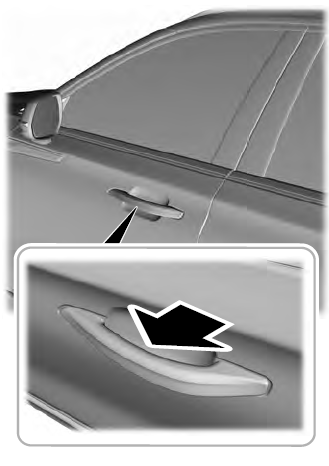Lincoln Aviator: Engine Ignition - 3.0L EcoBoost / Removal and Installation - Spark Plugs
Removal
-
Remove the ignition coil-on-plugs.
Refer to: Ignition Coil-On-Plug (303-07A Engine Ignition - 3.0L EcoBoost, Removal and Installation).
-
Use compressed air to remove any foreign material in the spark plug well before removing the spark plugs.
-
NOTICE: Do not remove the spark plugs when the engine is hot or cold soaked. Spark plug thread or cylinder head damage can occur. Make sure that the engine is warm (hand touch after cooling down) prior to spark plug removal.
NOTICE: If a spark plug is dropped, internal damage may result and the spark plug must be discarded. The use of a damaged spark plug may cause cylinder misfire resulting in engine damage.
Remove the spark plugs.
.jpg) |
-
Inspect the spark plugs.
Refer to: Spark Plug Inspection (303-00 Engine System - General Information, General Procedures).
Installation
-
NOTICE: If a spark plug is dropped, internal damage may result and the spark plug must be discarded. The use of a damaged spark plug may cause cylinder misfire resulting in engine damage.
Install and tighten the spark plugs.
Torque: 133 lb.in (15 Nm)
.jpg) |
-
Install the ignition coil-on-plugs.
Refer to: Ignition Coil-On-Plug (303-07A Engine Ignition - 3.0L EcoBoost, Removal and Installation).
 Diagnosis and Testing - Engine Ignition
Diagnosis and Testing - Engine Ignition
Diagnostic Trouble Code (DTC) Chart
Diagnostics in this manual assume a certain skill level and knowledge of Ford-specific diagnostic practices.REFER to: Diagnostic Methods (100-00 General Information, Description and Operation)...
 Removal and Installation - Ignition Coil-On-Plug
Removal and Installation - Ignition Coil-On-Plug
Special Tool(s) /
General Equipment
Side Cutter Pliers
Removal
Remove the retainers and the RH side engine compartment cover.
Remove the retainers and the LH side engine compartment cover...
Other information:
Lincoln Aviator 2020-2025 Owners Manual: Text Messaging
Setting Text Message Notification iOS Go to the settings menu on your cell phone. Select Bluetooth. Select the information icon to the right of your vehicle. Switch text message notification on. Android Go to the settings menu on your cell phone...
Lincoln Aviator 2020-2025 Service Manual: General Procedures - Fuel Tank Draining
Special Tool(s) / General Equipment 292-00004Fuel Tanker 100 GPM Draining WARNING: Before beginning any service procedure in this section, refer to Safety Warnings in section 100-00 General Information. Failure to follow this instruction may result in serious personal injury...
Categories
- Manuals Home
- Lincoln Aviator Owners Manual
- Lincoln Aviator Service Manual
- Description and Operation - Body and Frame
- Interior Lamps
- Opening and Closing the Hood
- New on site
- Most important about car
Activating Intelligent Access
The intelligent access key must be within 3 ft (1 m) of the door or luggage compartment you intend to lock or unlock.
At a Door
Electronic door handles are on each door. Gently depress the switch inside the exterior door handle to unlock and open the door. An unlock symbol illuminates on the door window trim indicating your vehicle is unlocked.

